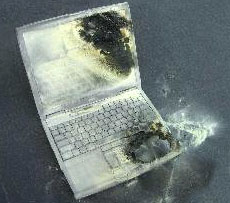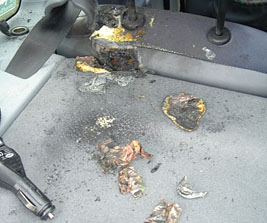Lithium-ion Safety Concerns
When Sony introduced the first lithium-ion battery in 1991, they knew of the potential safety risks. A recall of the previously released rechargeable metallic lithium battery was a bleak reminder of the discipline one must exercise when dealing with this high energy-dense battery system.
Pioneering work for the lithium battery began in 1912, but is was not until the early 1970′s when the first non-rechargeable lithium batteries became commercially available. Attempts to develop rechargeable lithium batteries followed in the eighties. These early models were based on metallic lithium and offered very high energy density. However, inherent instabilities of lithium metal, especially during charging, put a damper on the development. The cell had the potential of a thermal run-away. The temperature would quickly rise to the melting point of the metallic lithium and cause a violent reaction. A large quantity of rechargeable lithium batteries had to be recalled in 1991 after the pack in a cellular phone released hot gases and inflicted burns to a man’s face.
Because of the inherent instability of lithium metal, research shifted to a non-metallic lithium battery using lithium ions. Although slightly lower in energy density, the lithium-ion system is safe, providing certain precautions are met when charging and discharging. Today, lithium-ion is one of the most successful and safe battery chemistries available. Two billion cells are produced every year.
Lithium-ion cells with cobalt cathodes hold twice the energy of a nickel-based battery and four-times that of lead acid. Lithium-ion is a low maintenance system, an advantage that most other chemistries cannot claim. There is no memory and the battery does not require scheduled cycling to prolong its life. Nor does lithium-ion have the sulfation problem of lead acid that occurs when the battery is stored without periodic topping charge. Lithium-ion has a low self-discharge and is environmentally friendly. Disposal causes minimal harm.
Long battery runtimes have always been the wish of many consumers. Battery manufacturers responded by packing more active material into a cell and making the electrodes and separator thinner. This enabled a doubling of energy density since lithium-ion was introduced in 1991.
The high energy density comes at a price. Manufacturing methods become more critical the denser the cells become. With a separator thickness of only 20-25µm, any small intrusion of metallic dust particles can have devastating consequences. Appropriate measures will be needed to achieve the mandated safety standard set forth by UL 1642. Whereas a nail penetration test could be tolerated on the older 18650 cell with a capacity of 1.35Ah, today’s high-density 2.4Ah cell would become a bomb when performing the same test. UL 1642 does not require nail penetration. Lithium-ion batteries are nearing their theoretical energy density limit and battery manufacturers are beginning to focus on improving manufacturing methods and increasing safety.
Recall of lithium-ion batteries
With the high usage of lithium-ion in cell phones, digital cameras and laptops, there are bound to be issues. A one-in-200,000 failure rate triggered a recall of almost six million lithium-ion packs used in laptops manufactured by Dell and Apple. Heat related battery failures are taken very seriously and manufacturers chose a conservative approach. The decision to replace the batteries puts the consumer at ease and lawyers at bay. Let’s now take a look at what’s behind the recall.
Sony Energy Devices (Sony), the maker of the lithium-ion cells in question, says that on rare occasions microscopic metal particles may come into contact with other parts of the battery cell, leading to a short circuit within the cell. Although battery manufacturers strive to minimize the presence of metallic particles, complex assembly techniques make the elimination of all metallic dust nearly impossible.
Figure 1: Lithium-ion battery damages a laptop.

Safety issues are enticing battery manufacturers to change the manufacturing process. According to Sony, contamination of Cu, Al, Fe and Ni particles during the manufacturing process may cause an internal short circuit.
A mild short will only cause an elevated self-discharge. Little heat is generated because the discharging energy is very low. If, however, enough microscopic metal particles converge on one spot, a major electrical short can develop and a sizable current will flow between the positive and negative plates. This causes the temperature to rise, leading to a thermal runaway, also referred to ‘venting with flame.’
Lithium-ion cells with cobalt cathodes (same as the recalled laptop batteries) should never rise above 130°C (265°F). At 150°C (302°F) the cell becomes thermally unstable, a condition that can lead to a thermal runaway in which flaming gases are vented.
During a thermal runaway, the high heat of the failing cell can propagate to the next cell, causing it to become thermally unstable as well. In some cases, a chain reaction occurs in which each cell disintegrates at its own timetable. A pack can get destroyed within a few short seconds or linger on for several hours as each cell is consumed one-by-one. To increase safety, packs are fitted with dividers to protect the failing cell from spreading to neighboring cells.
Safety level of lithium-ion systems
There are two basic types of lithium-ion chemistries: cobalt and manganese (spinel). To achieve maximum runtime, cell phones, digital cameras and laptops use cobalt-based lithium-ion. Manganese is the newer of the two chemistries and offers superior thermal stability. It can sustain temperatures of up to 250°C (482°F) before becoming unstable. In addition, manganese has a very low internal resistance and can deliver high current on demand. Increasingly, these batteries are used for power tools and medical devices. Hybrid and electric vehicles will be next.
The drawback of spinel is lower energy density. Typically, a cell made of a pure manganese cathode provides only about half the capacity of cobalt. Cell phone and laptop users would not be happy if their batteries quit halfway through the expected runtime. To find a workable compromise between high energy density, operational safety and good current delivery, manufacturers of lithium-ion batteries can mix the metals. Typical cathode materials are cobalt, nickel, manganese and iron phosphate.
Let me assure the reader that lithium-ion batteries are safe and heat related failures are rare. The battery manufacturers achieve this high reliability by adding three layers of protection. They are: [1] limiting the amount of active material to achieve a workable equilibrium of energy density and safety; [2] inclusion of various safety mechanisms within the cell; and [3] the addition of an electronic protection circuit in the battery pack.
These protection devices work in the following ways: The PTC device built into the cell acts as a protection to inhibit high current surges; the circuit interrupt device (CID) opens the electrical path if an excessively high charge voltage raises the internal cell pressure to 10 Bar (150 psi); and the safety vent allows a controlled release of gas in the event of a rapid increase in cell pressure. In addition to the mechanical safeguards, the electronic protection circuit external to the cells opens a solid-state switch if the charge voltage of any cell reaches 4.30V. A fuse cuts the current flow if the skin temperature of the cell approaches 90°C (194°F). To prevent the battery from over-discharging, the control circuit cuts off the current path at about 2.50V/cell. In some applications, the higher inherent safety of the spinel system permits the exclusion of the electric circuit. In such a case, the battery relies wholly on the protection devices that are built into the cell.
We need to keep in mind that these safety precautions are only effective if the mode of operation comes from the outside, such as with an electrical short or a faulty charger. Under normal circumstances, a lithium-ion battery will simply power down when a short circuit occurs. If, however, a defect is inherent to the electrochemical cell, such as in contamination caused by microscopic metal particles, this anomaly will go undetected. Nor can the safety circuit stop the disintegration once the cell is in thermal runaway mode. Nothing can stop it once triggered.
What every battery user should know
A major concern arises if static electricity or a faulty charger has destroyed the battery’s protection circuit. Such damage can permanently fuse the solid-state switches in an ON position without the user knowing. A battery with a faulty protection circuit may function normally but does not provide protection against abuse.
Another safety issue is cold temperature charging. Consumer grade lithium-ion batteries cannot be charged below 0°C (32°F). Although the packs appear to be charging normally, plating of metallic lithium occurs on the anode while on a sub-freezing charge. The plating is permanent and cannot be removed. If done repeatedly, such damage can compromise the safety of the pack. The battery will become more vulnerable to failure if subjected to impact, crush or high rate charging.
Some companies produces many non-brand replacement batteries that are popular with cell phone users because of low price. Many of these batteries don’t provide the same high safety standard as the main brand equivalent. A wise shopper spends a little more and replaces the battery with an approved model. Figure 1 shows a cell phone that was destroyed while charging in a car. The owner believes that a no-name pack caused the destruction.
Figure 2: A cell phone with a no-brand battery that vented with flame while charging in the back of a car.

To prevent the infiltration of unsafe packs on the market, most manufacturers sell lithium-ion cells only to approved battery pack assemblers. The inclusion of an approved safety circuit is part of the purchasing requirement. This makes it difficult for a hobbyist to purchase single lithium-ion cells off-the-shelf in a store. The hobbyist will have no other choice than to revert to nickel-based batteries.
The safety precaution is especially critical on larger batteries, such as laptop packs. The hazard is so much greater than on a small cell phone battery if something goes wrong. For this reason, many laptop manufacturers secure their batteries with a secret code that only the matching computer can access. This prevents non-brand-name batteries from flooding the market. The drawback is a higher price for the replacement battery. Readers of www.hrl-battery.com often ask me for a source of cheap laptop batteries. I have to disappoint the shoppers by directing them to the original vendor for a brand name pack.
Considering the number of lithium-ion batteries used on the market, this energy storage system has caused little harm in terms of damage and personal injury. In spite of the good record, its safety is a hot topic that gets high media attention, even on a minor mishap. This caution is good for the consumer because we will be assured that this popular energy storage device is safe. After the recall of Dell and Apple laptop batteries, cell manufacturers will not only try packing more energy into the pack but will attempt to make it more bulletproof.
Post time: Aug-01-2019




